Written Driving Practice Questions
1/91
There's no tags or description
Looks like no tags are added yet.
Name | Mastery | Learn | Test | Matching | Spaced |
|---|
No study sessions yet.
92 Terms
Warning, slippery when wet.
This sign means:
Warning, curves ahead.
Apply your brakes quickly.
Warning, watch for drunk drivers.
Warning, slippery when wet.
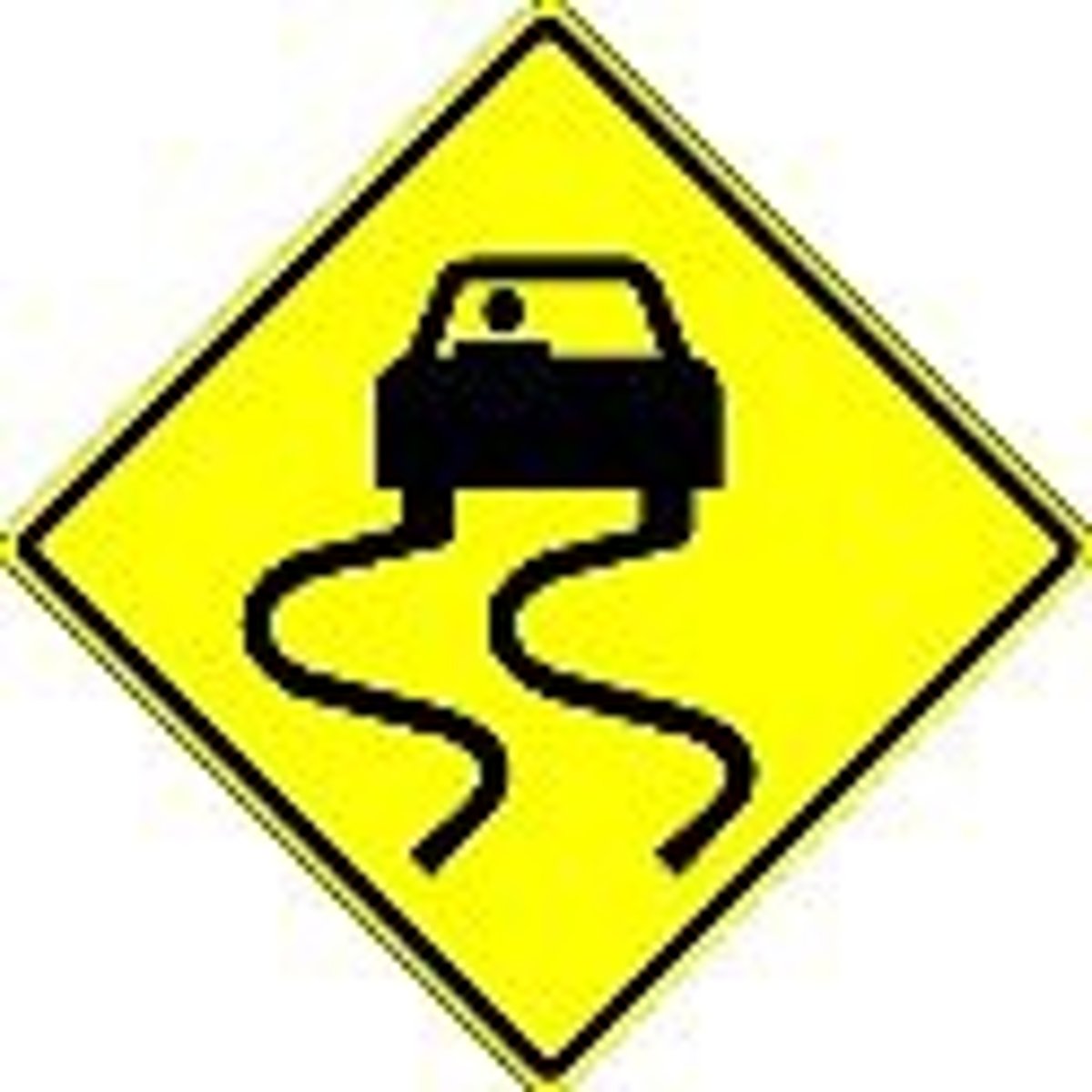
Watch for people working on or near the roadway.
This sign means:
Yield the right-of-way.
Watch for people working on or near the roadway.
Expect a traffic signal ahead.
Warning, road ends.

A solid yellow line on your side of the center line means:
Slow down.
Do not pass.
Keep right on hills.
Pass with caution.
Do not pass.
If you refuse to take a blood alcohol content test, you will lose your driver license for:
90 days.
At least 2 years.
At least 1 year.
6 months.
At least 1 year.
When riding at night, your bicycle must have a white headlight visible for:
500 feet.
300 feet.
400 feet.
600 feet.
500 feet.
A yellow light that flashes on and off means:
Speed up to clear the intersection quickly.
Stop and look, then go if there is no traffic.
Slow down and proceed with caution.
Stop and wait for a green light.
Slow down and proceed with caution.
You must dim your high-beam lights when within:
250 feet of an oncoming vehicle.
500 feet of an oncoming vehicle.
100 feet of an oncoming vehicle.
300 feet of an oncoming vehicle.
500 feet of an oncoming vehicle.
If you see side-by-side red lights flashing at a railroad crossing, you must:
Maintain speed and cross the railroad.
Stop.
Signal before going any further.
Slow down.
Stop.
When in travel lanes on the roadway:
You may stop to let out passengers.
Don't stop for any reason. Keep moving until you can safely pull off the road.
You may stop to look up an address.
You may make a U-turn or back up if you get on the wrong entrance ramp of the freeway.
Don't stop for any reason. Keep moving until you can safely pull off the road.
If you stop along the road at night:
Turn on your emergency flashers and leave your low beams on.
Use your parking lights only.
Turn off all your lights.
Use your headlights only.
Turn off all your lights.
Curve ahead, 35 mph or less recommended.
This sign means:
There is a 35 mph speed zone after the curve ahead.
Drive no less than 35 mph around the curve ahead.
Curve ahead, 35 mph or less recommended.
Stay in the right-hand lane if not driving over 35mph.

In Washington State, a person is legally drunk when their Blood Alcohol Content (BAC) level is:
At or above .01 percent.
At or above .12 percent.
At or above .08 percent.
At or above 1 percent.
At or above .08 percent.
The correct way to use a freeway exit ramp is:
Keep your speed constant once in the exit ramp.
Slow down before entering the exit ramp.
Pass slower traffic in the exit ramp.
Don't slow down until you move onto the exit ramp.
Don't slow down until you move onto the exit ramp.
At an uncontrolled intersection, you must:
Take the right of way cautiously.
Speed up and clear the intersection quickly.
Wait for the other traffic to signal you to go.
Slow down and yield to any vehicle in the intersection and to those coming from the right.
Slow down and yield to any vehicle in the intersection and to those coming from the right.
To avoid being in a truck or bus driver's blind spot and help them see, you should:
Flash your lights.
Never pass them.
Sound your horn.
Avoid driving on either side and don't tailgate.
Avoid driving on either side and don't tailgate.
When you see a school bus on a road with 2 lanes traveling in opposite directions, you must stop:
Only if you're going in the same direction as the bus.
If the red warning lights on the bus are flashing.
If the bus is off the road and the yellow lights are flashing.
If the bus has flashing yellow lights.
If the red warning lights on the bus are flashing.
If your brakes stop working, you should first:
Shift the car's transmission into neutral.
Jump out of the vehicle immediately.
Pump the brake pedal several times and try to build up brake pressure.
Flash your lights at other traffic.
Pump the brake pedal several times and try to build up brake pressure.
No right turn.
This sign means:
No right turn.
Watch for traffic on your right.
You must turn right.
Don't park on the right of the street.
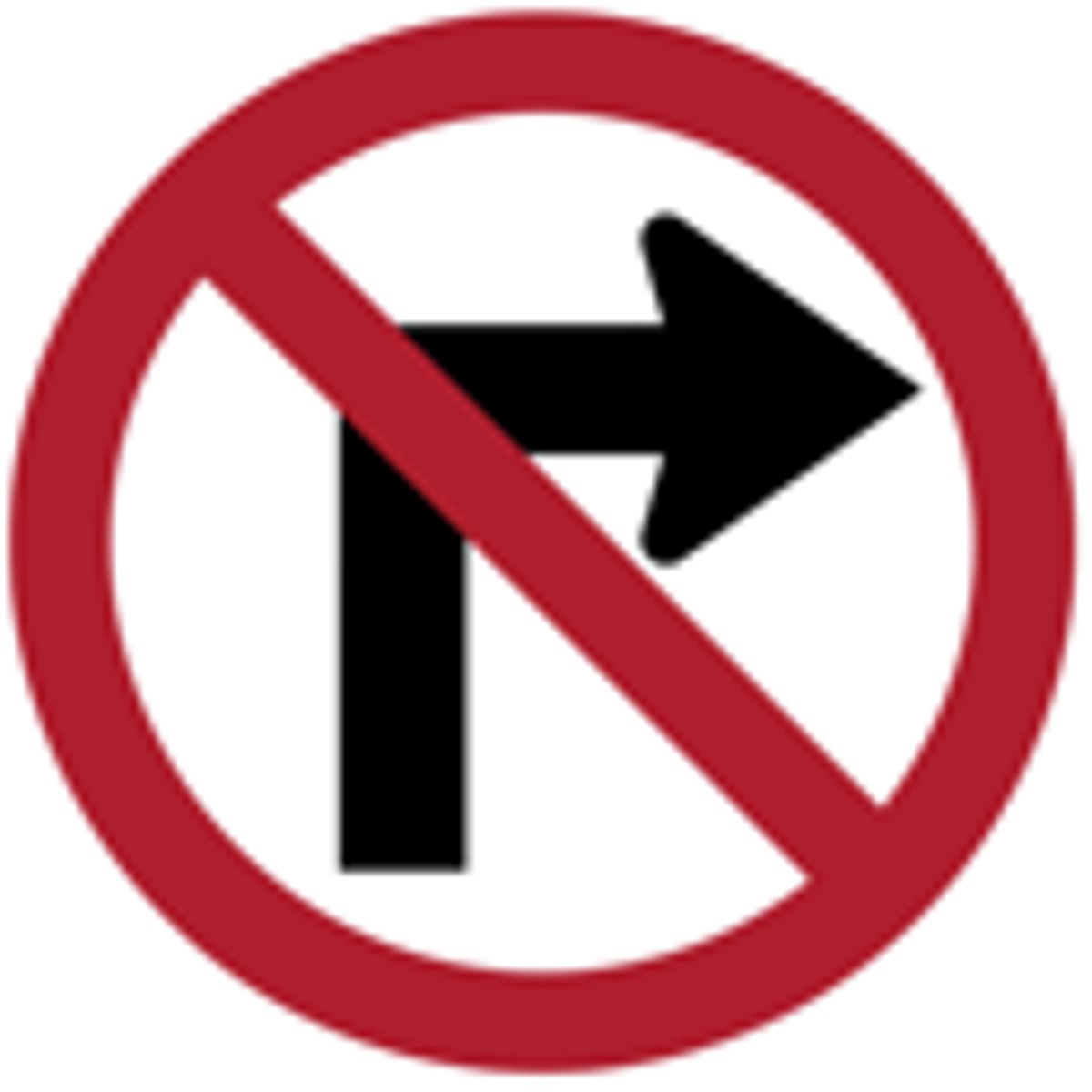
A bicyclist who doesn't obey traffic laws:
Can be ticketed.
Will always receive a warning from law enforcement.
Will have their bicycle impounded.
Is okay, because bicyclists don't have to obey traffic laws.
Can be ticketed.
You may park or stop along the shoulder of the freeway:
If you need to look at a map for directions.
Only if you have an emergency.
If no part of your vehicle is on the road.
As long as you turn on your 4-way (emergency) flashers.
Only if you have an emergency.
By law, your vehicle's lights must be turned on from:
1 hour after sunset until 1 hour after sunrise.
30 minutes after sunset until 30 minutes before sunrise.
30 minutes before sunset until 30 minutes before sunrise.
1 hour before sunset until 1 hour before sunrise.
30 minutes after sunset until 30 minutes before sunrise.
If you're going to turn left onto a 1-way street, you should complete the turn into:
Either lane.
The right lane.
The lane closest to the one you came from.
Neither lane.
The lane closest to the one you came from.
When passing another vehicle on a road with 2 lanes traveling in opposite directions, you should:
Return to the right side of the roadway immediately.
Remain in the left lane if you intend to turn left.
Drive in either lane.
Return to the driving lane when there's enough room between you and the vehicle you passed.
Return to the driving lane when there's enough room between you and the vehicle you passed.
When the driver behind you wants to pass, you should:
Slow down to allow room in front of your vehicle and for the other driver to complete the pass sooner.
Change lanes.
Speed up.
Go the same speed.
Slow down to allow room in front of your vehicle and for the other driver to complete the pass sooner.
Divided highway ends.
This sign means:
Curves ahead.
Bumps in the road.
Divided highway starts.
Divided highway ends.
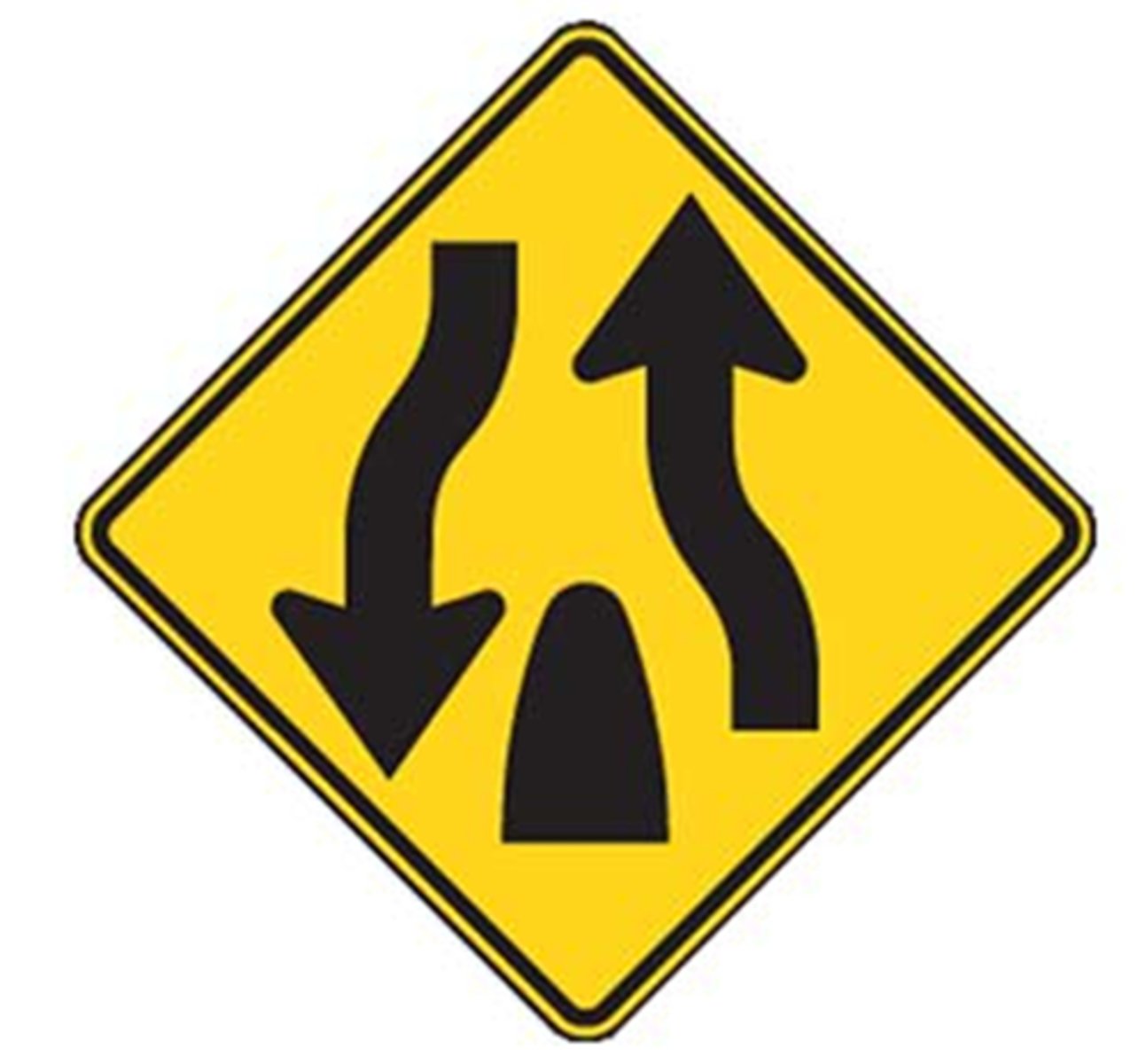
The most important thing to remember in backing a car is to:
Keep one foot on the brake while backing.
Look back carefully and yield to other vehicles and pedestrians.
Use the rearview mirror only while backing.
Keep both hands on the steering wheel.
Look back carefully and yield to other vehicles and pedestrians.
On a road with 2 lanes traveling in opposite directions, slow-moving vehicles should pull over when safe to let others pass if:
The road is posted with slow moving vehicle signs.
1 vehicle is behind you.
2 or more vehicles form a line behind you and it's unsafe for them to pass.
5 or more vehicles form a line behind you and it's unsafe for them to pass.
5 or more vehicles form a line behind you and it's unsafe for them to pass.
To change lanes you should
Signal, check your mirrors, and change lanes.
Signal, check your mirrors, check your blind spot in the direction you plan to move, and change lanes.
Check your mirrors, signal, and change lanes.
Signal and change lanes.
Signal, check your mirrors, check your blind spot in the direction you plan to move, and change lanes.
Before you change directions, you must keep your turn signals on for at least:
125 feet.
50 feet.
100 feet.
75 feet.
100 feet.
On slippery roads, you should:
Go the speed limit, with caution.
Slow down.
Not drive faster than 20 mph.
Go faster.
Slow down.
Drivers entering an intersection to turn left:
Must not enter an intersection unless they can get through it without having to stop.
Must wait for the green arrow before turning left.
Can wait in the intersection until they can turn left.
Can wait in the intersection until the light turns yellow before turning left.
Must not enter an intersection unless they can get through it without having to stop.
When driving on a road with 2 lanes traveling in opposite directions:
Use the right lane except when you're legally passing another vehicle.
You may use the left lane if you're going to turn left.
Use the lane with the least traffic.
You may drive in either lane.
Use the right lane except when you're legally passing another vehicle.
A traffic signal showing a steady red light means:
Quickly drive through the intersection.
Slow down and yield to other traffic.
Stop, look for danger, and then go across the intersection.
Stop, don't travel straight ahead while the light is red.
Stop, don't travel straight ahead while the light is red.
Don't park within:
30 feet of a fire hydrant.
15 feet of a fire hydrant.
10 feet of a fire hydrant.
20 feet of a fire hydrant.
15 feet of a fire hydrant.
The speed limit is 40 miles per hour.
This sign means:
You should drive with the flow of traffic.
Limit your speed for the next 40 miles.
The speed limit is 40 miles per hour.
Speed limits are enforced for the next 40 miles.
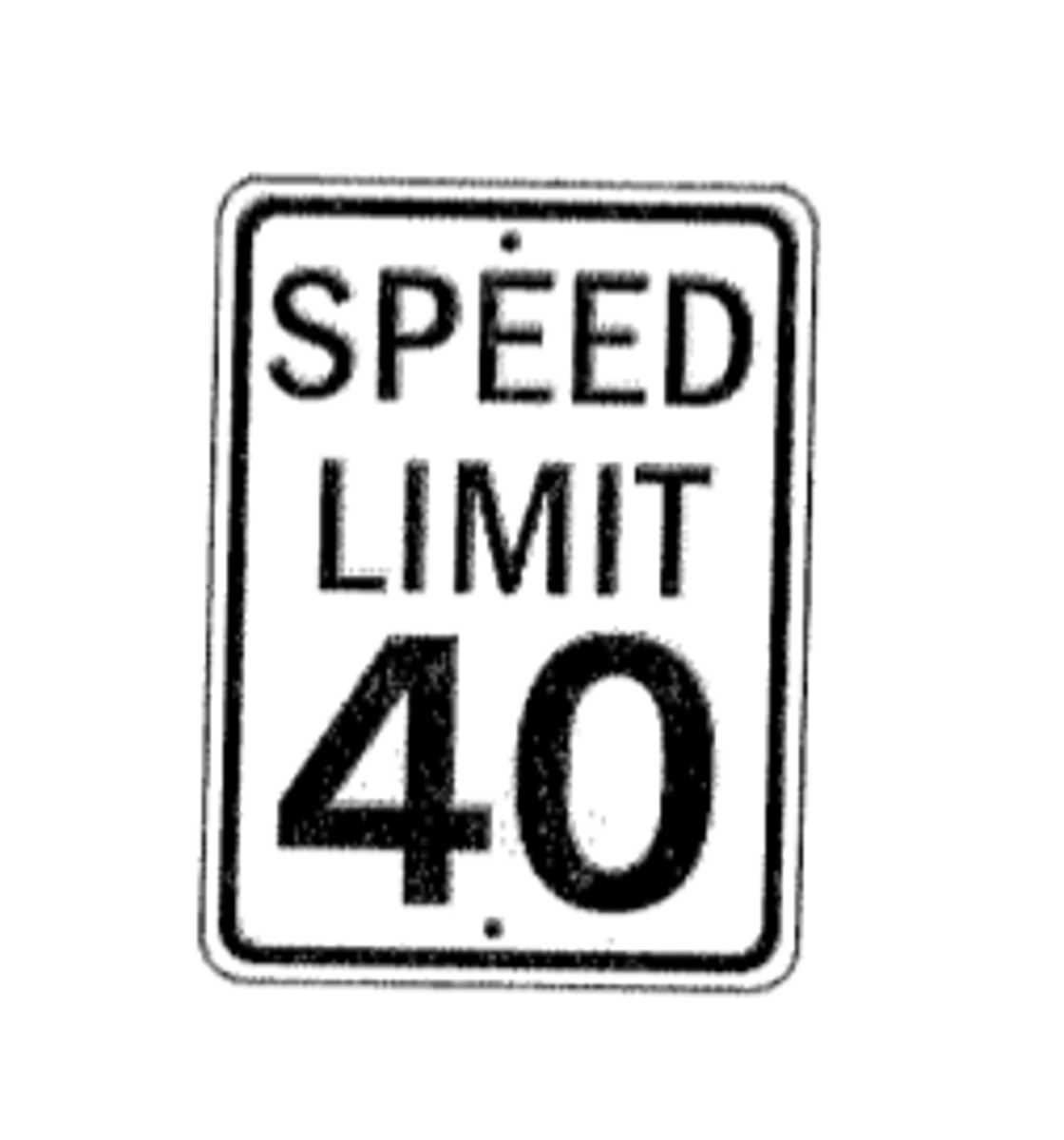
Warning sign (caution).
This sign is a:
Service sign.
Warning sign (caution).
Stop sign (full stop).
Regulatory sign (traffic rules).
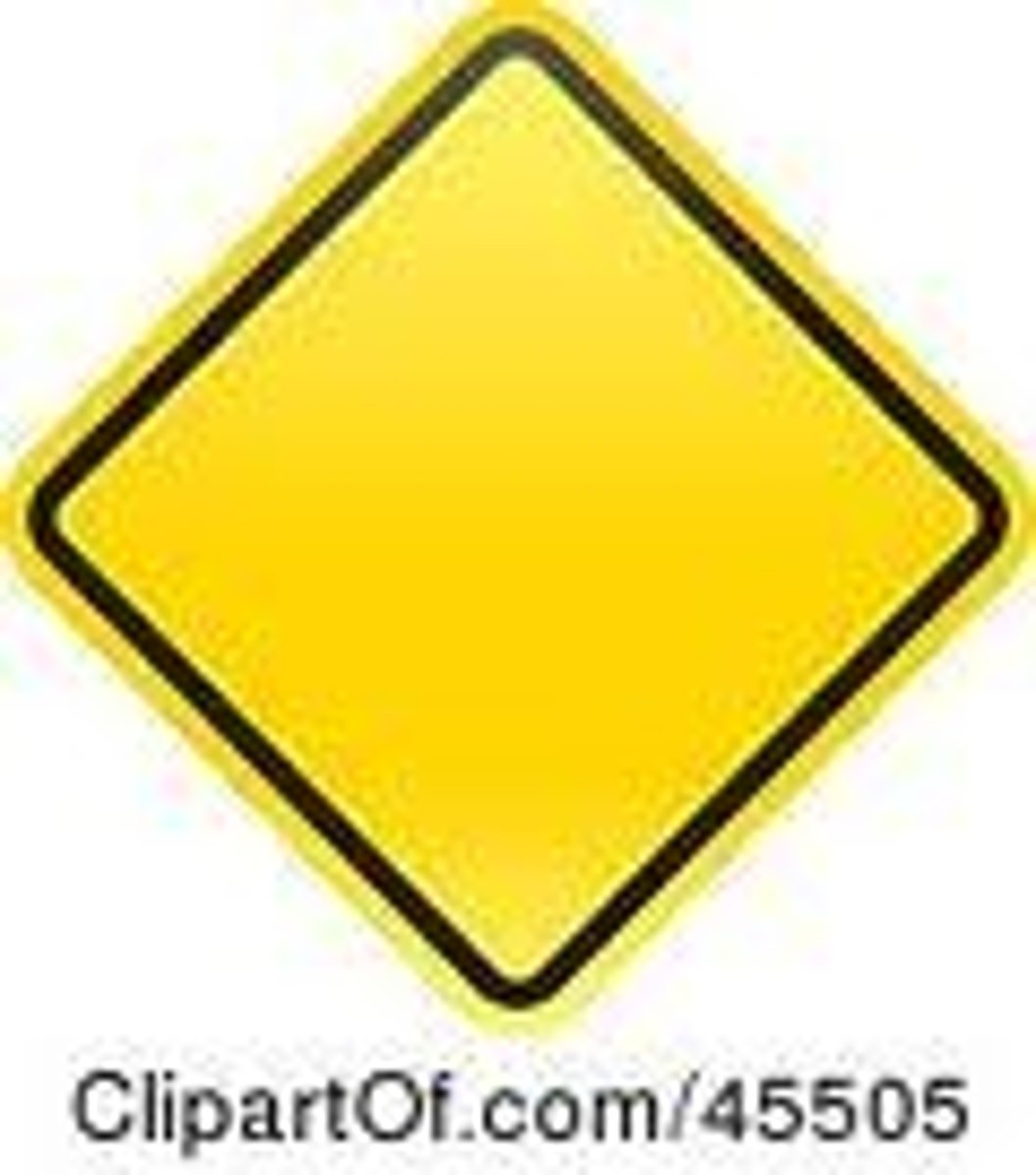
At night, slow down and always:
Use your dome light to help you see your speedometer.
Use high beams whenever there are no oncoming vehicles.
Use sunglasses to reduce glare from headlights.
Use your high beams until other drivers dim their lights.
Use high beams whenever there are no oncoming vehicles.
If there is an injury, a death, or $700 or more in damage to any 1 person's property, you must report an accident to law enforcement officials within:
5 days
10 days
4 days
2 days.
4 days
The buyer of a vehicle must transfer ownership and registration:
By the end of the year.
Within 60 days from the date of purchase.
Before the license plate expires.
Within 15 days from the date of purchase.
Within 15 days from the date of purchase.
When driving in fog
Use your high beams.
Use your parking lights.
Use your low beams.
It makes no difference which lights you use.
Use your low beams.
If your car starts to skid, turn your steering wheel:
In the direction you want the vehicle to go.
In any direction. It doesn't matter.
To keep the front wheels straight.
In the opposite direction of the skid.
In the direction you want the vehicle to go.
When parking uphill with a curb, set the parking brake and:
Turn your steering wheel away from the curb.
Keep the front tires straight ahead.
Keep the rear tires against the curb.
Turn your steering wheel toward the curb.
Turn your steering wheel away from the curb.
Watch for bicycles.
This sign means:
Bicycles not allowed.
Bicycle repair shop ahead.
Bicycles have the right-of-way.
Watch for bicycles.
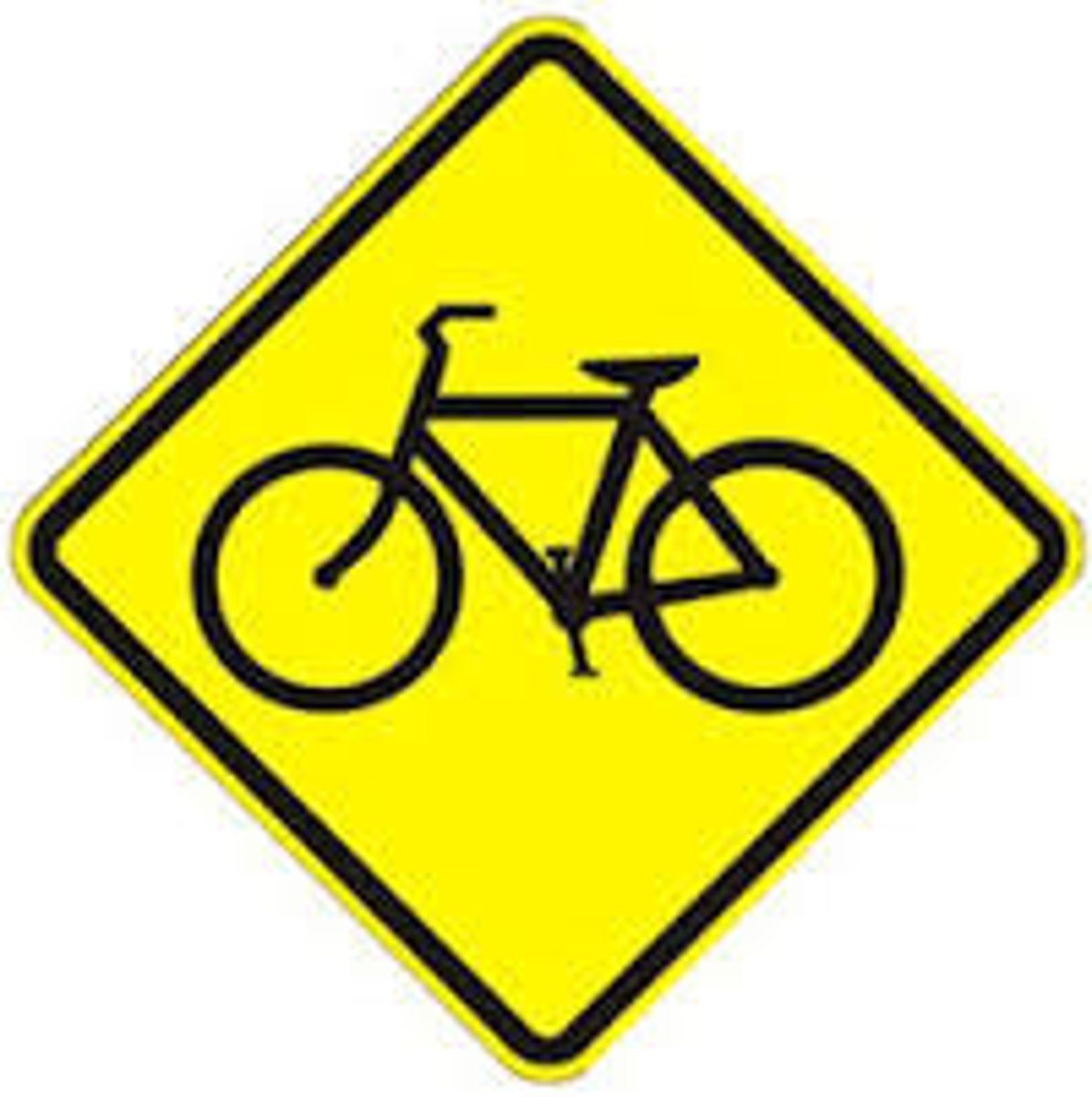
To help avoid crashes, you should:
Avoid driving during rush hour
Ignore other drivers on the road
Drive on side streets and back roads
Communicate with other drivers on the road
Communicate with other drivers on the road.
Generally, how many drinks of alcohol will the human body get rid of each hour?
3 drinks.
½ a drink.
2 drinks.
1 drink.
1 drink.
A first conviction for driving under the influence of alcohol or any drug can result in a license suspension for at least:
90 days.
30 days.
2 years
1 year.
1 year.
When entering traffic from a private driveway:
You must yield to vehicles already on the main road.
Enter only if there is a traffic light.
You have the right-of-way over other traffic.
Have someone stop the traffic on the road you're entering.
You must yield to vehicles already on the main road.
While driving at the speed limit, you see this sign. You should:
Be ready to go faster when the speed limit increases.
Keep the same speed, but don't pass.
Prepare to slow down because the speed limit is reduced ahead.
Increase your speed immediately.
Prepare to slow down because the speed limit is reduced ahead.
When you see other drivers around you acting or reacting in anger:
Slow down, move over, or do whatever you can safely.
Distance yourself from the situation.
Don't make eye contact.
All of these.
All of these.
Watch for children and be ready to stop.
At a school crossing sign, you should:
Always sound your horn when you see children.
Be ready to help children crossing the street.
Watch for children and be ready to stop.
Always stop, whether there's a stop sign or not.
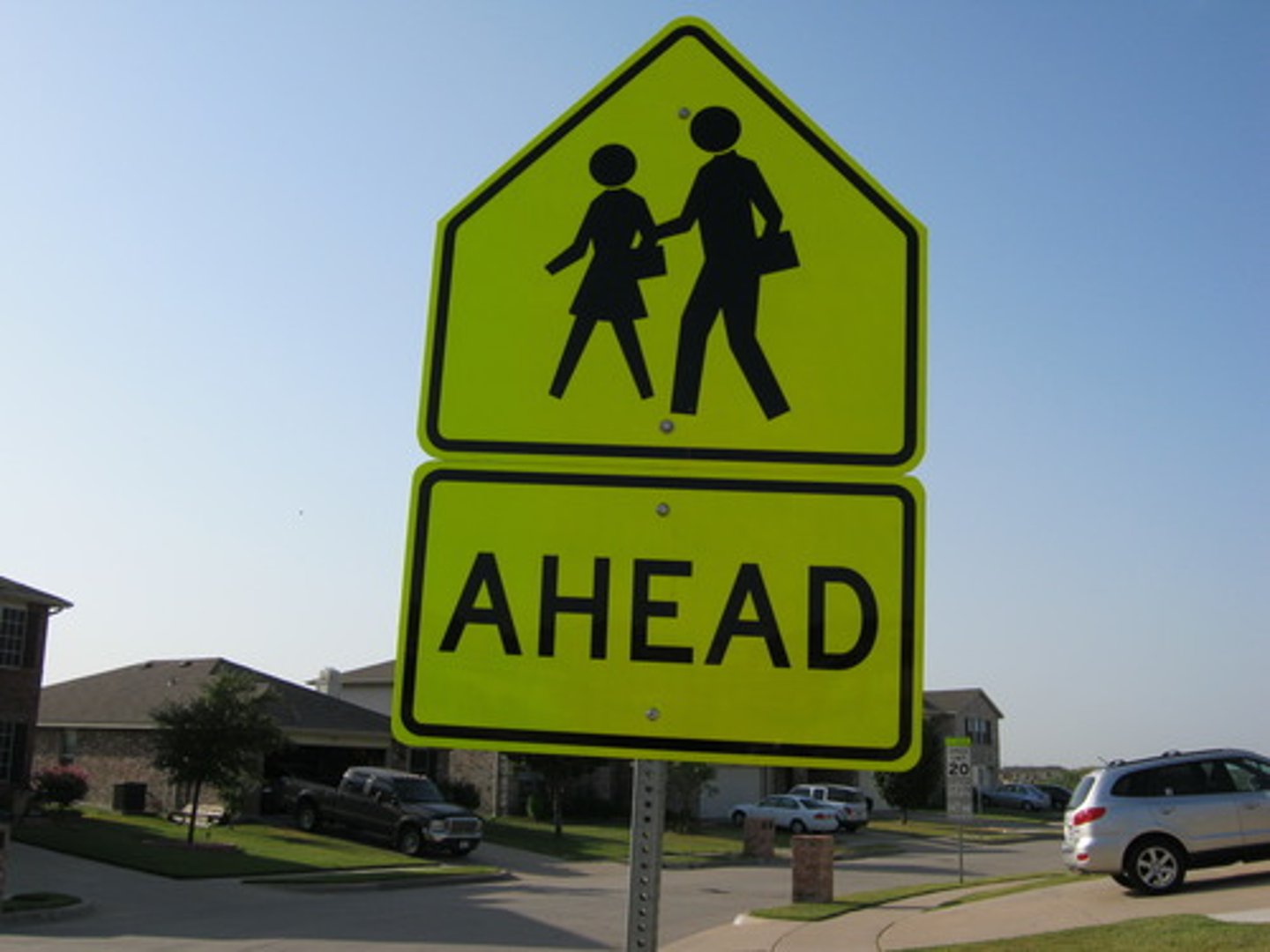
When a school bus is stopped off the road without flashing lights, you should:
Use caution as you pass the bus, since you're not required to stop.
Stop until the bus moves on, regardless of which side of the road you're on.
Stop until the bus driver signals you to go.
Stop only if you're on the same side of the road as the bus.
Use caution as you pass the bus, since you're not required to stop.
To be parked legally, a vehicle must be within:
18 inches of the curb.
24 inches of the curb.
12 inches of the curb.
6 inches of the curb.
12 inches of the curb.
Pedestrian crossing ahead.
This sign means:
Be alert for construction workers on the road.
Pedestrian crossing ahead.
Pedestrians walking along the road ahead.
Pedestrians must not cross here.
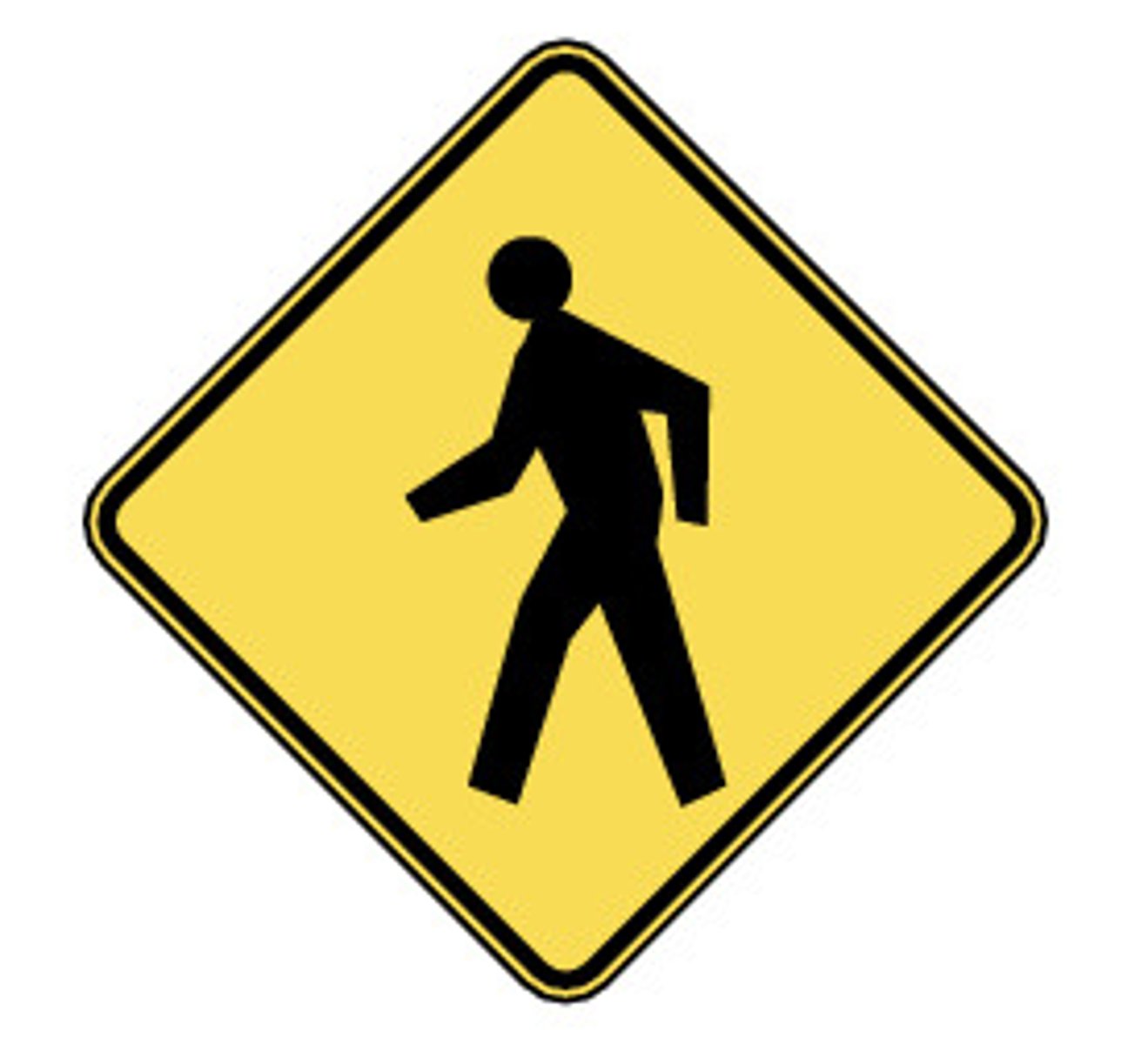
Slow down and yield for trains.
What should you do when you see this sign?
Signal before going any further.
Stop.
Slow down and yield for trains.
Look for a train station ahead.
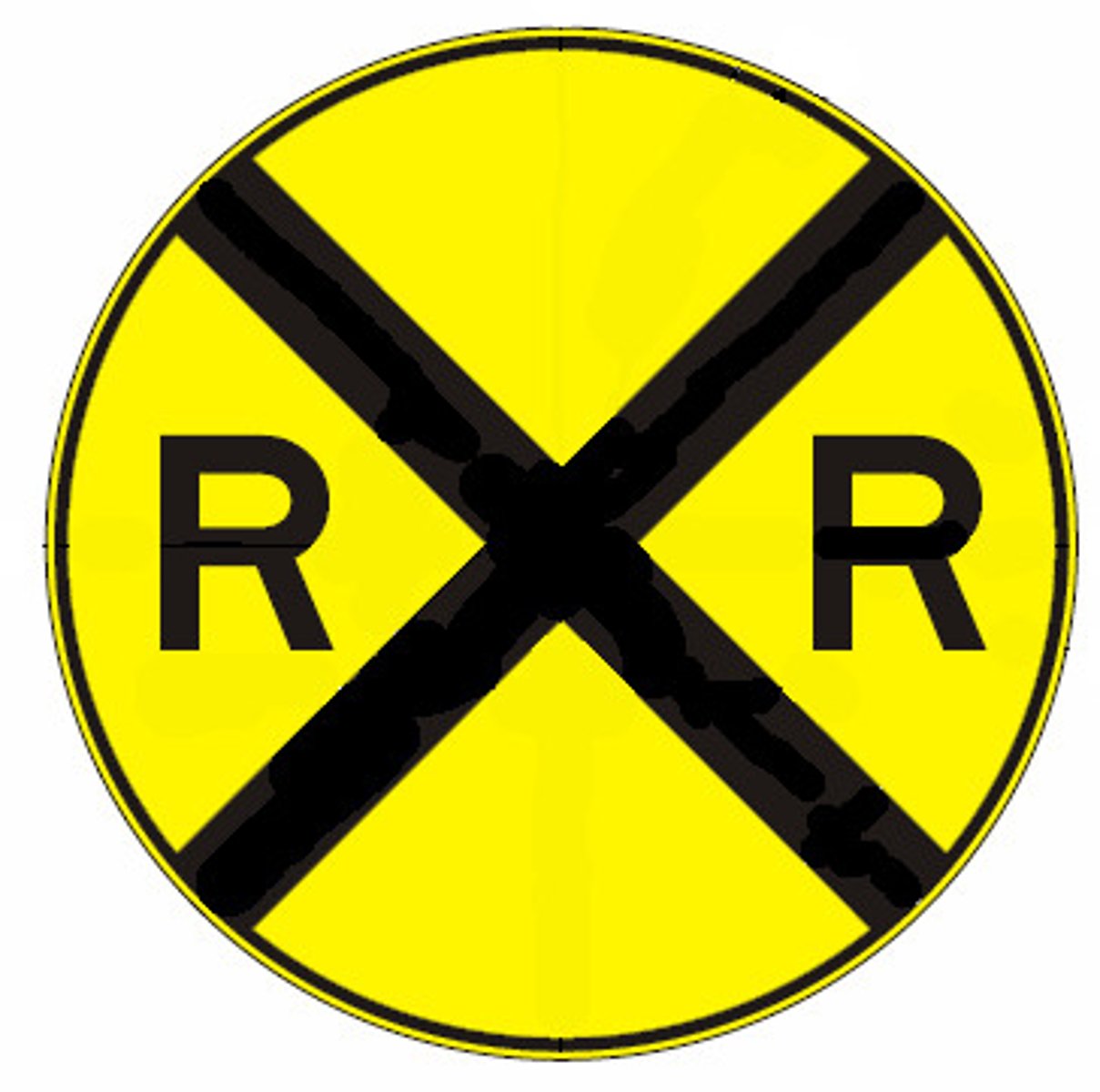
Don't follow other cars too closely because:
You may not see the vehicle's turn signals.
You may not have time to stop if the vehicle in front of you slows or stops suddenly.
You may not see the road between the cars.
You may not see the other vehicle's brake lights.
You may not have time to stop if the vehicle in front of you slows or stops suddenly.
Be cautious when large trucks, buses, and vehicles with trailers make turns because:
They may stop unexpectedly during the turn.
They make wide turns and may cross the center line.
They yield to all left-turn traffic.
They back up to get room to make the turn.
They make wide turns and may cross the center line.
Alcohol:
Slows reflexes and reaction time.
Wakes you up.
Improves your judgment.
Puts you to sleep.
Slows reflexes and reaction time.
To turn right at an intersection with a steady red light, you should:
Wait until you have a green turn arrow before turning.
Signal and wait until the light turns green.
Slow down and look for traffic before turning.
Stop, signal, then turn if it's safe and there's no sign prohibiting the turn on red
Stop, signal, then turn if it's safe and there's no sign prohibiting the turn on red
If you operate a motor vehicle registered in Washington State, you must:
Have liability insurance and carry an ID card proving you have such insurance.
Carry insurance only if you're under 18.
Carry insurance only if you have cars newer than 5 years.
Carry insurance only if you ride a motorcycle or drive a large truck.
Have liability insurance and carry an ID card proving you have such insurance.
On the freeway, you see a "merging traffic" sign. You should:
Slow down to allow traffic to enter.
Move to another lane, if safe, to let traffic enter.
Speed up to avoid congesting traffic.
Stay at your present speed.
Move to another lane, if safe, to let traffic enter.
When there's a shared center lane, you can:
Drive in this lane to pass.
Use this lane as a driving lane during rush hour.
Drive in this lane if you travel not more than 300 feet.
Drive in this lane as far as necessary, as long as you're turning left.
Drive in this lane if you travel not more than 300 feet.
To turn right, you should be in:
The center lane.
The left lane.
The lane that's closest to the direction you want to go.
Any one of the lanes.
The lane that's closest to the direction you want to go.
The maximum speed limit on streets in cities and towns, unless otherwise posted, is :
25 mph.
40 mph.
30 mph.
15 mph.
25 mph.
At an intersection with a roundabout island (traffic circle):
Always drive around the circle to the right.
Stop in the intersection to yield to traffic on the right.
Enter at any time, whether there is other traffic or pedestrians or not.
You can drive to the left of the roundabout when turning left.
Always drive around the circle to the right.
You must use your low beams when you're within:
300 feet of a vehicle you're following.
250 feet of a vehicle you're following.
500 feet of a vehicle you're following.
100 feet of a vehicle you're following.
300 feet of a vehicle you're following.
Always allow enough room to safely stop in emergencies by staying at least:
4 seconds behind the vehicle in front of you.
5 seconds behind the vehicle in front of you.
1 second behind the vehicle in front of you.
7 seconds behind the vehicle in front of you.
4 seconds behind the vehicle in front of you.
On a freeway, you realize you missed your turn or exit. You should:
Make the turn quickly from your lane of travel.
Stop and back up.
Signal other drivers to stop so you can turn.
Go on to the next turn, exit, or where you can safely turn around.
Go on to the next turn, exit, or where you can safely turn around.
On a sidewalk or in a crosswalk, bicyclists should ride slowly and:
Take the right-of-way without yielding to pedestrians.
Don't need to do everything possible to avoid colliding with a pedestrian.
Don't need to give an audible signal before passing any pedestrian.
Yield the right-of-way to any pedestrian.
Yield the right-of-way to any pedestrian.
Traffic signals ahead.
This sign means:
Emergency vehicles ahead.
Traffic signals ahead.
Uncontrolled intersection ahead.
4-way stop ahead.
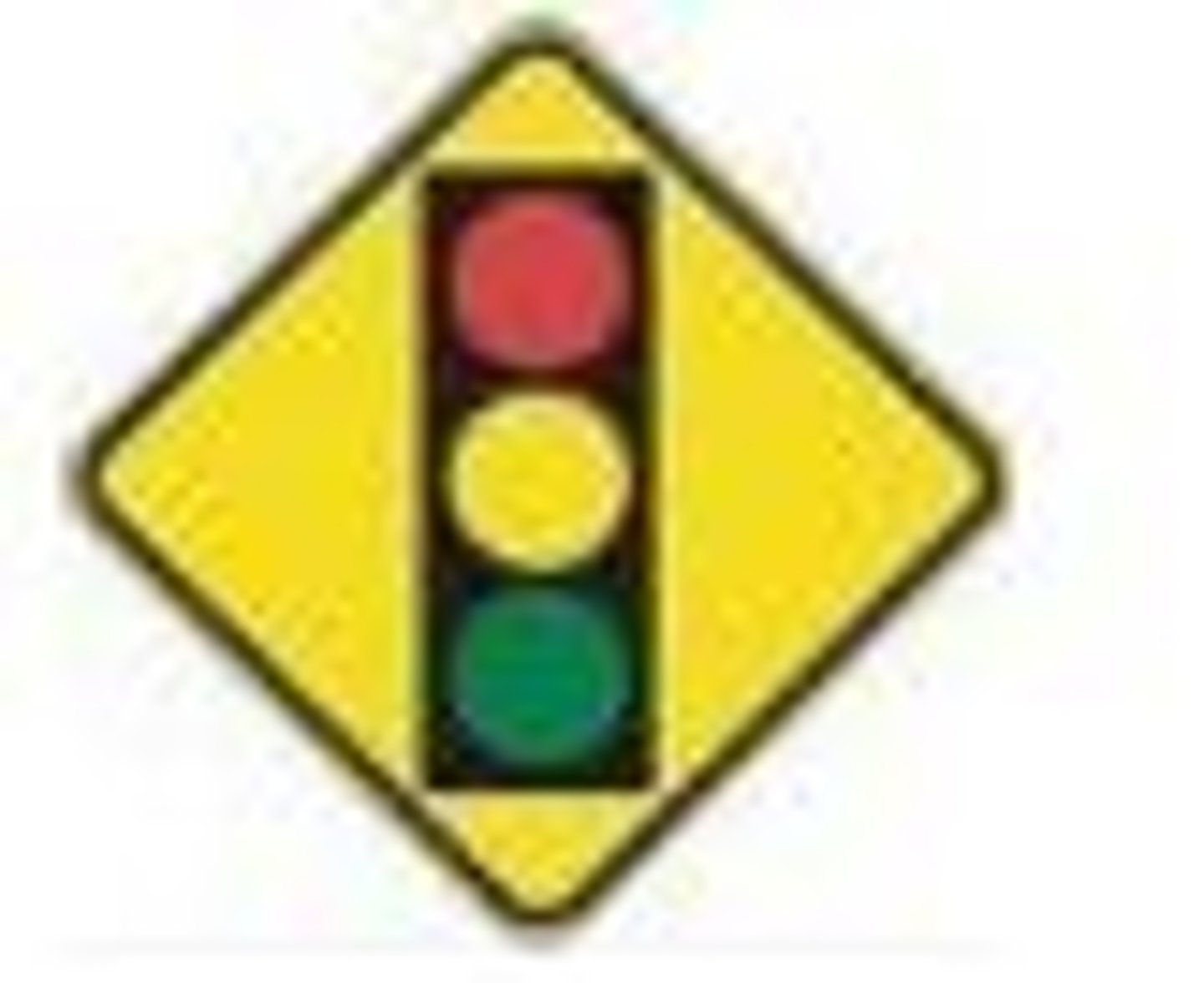
Follow a detour to the right.
This sign means you should:
Stay on the main highway if you can.
Do not enter.
Get ready to enter a 1-way street.
Follow a detour to the right.
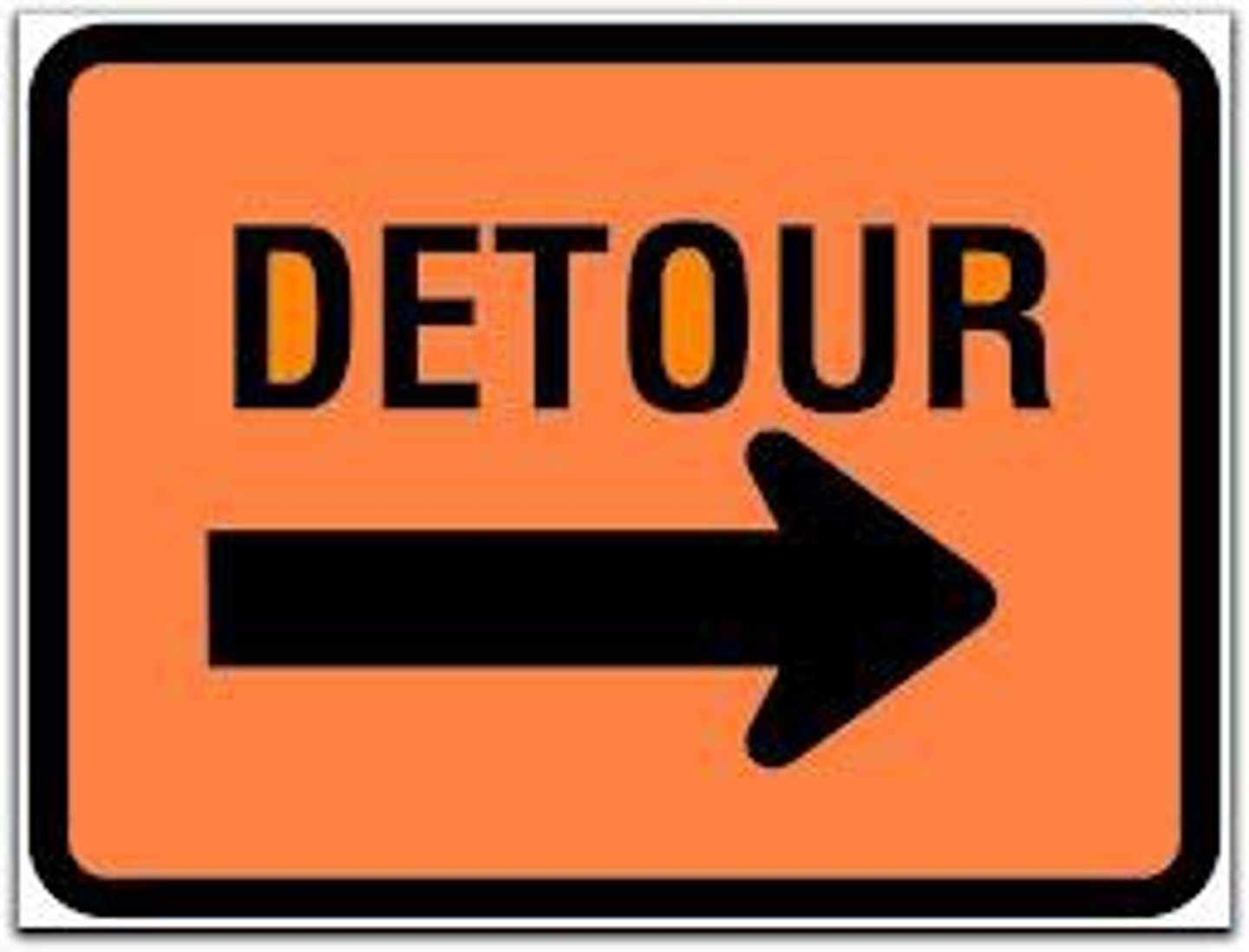
To enter a freeway:
Drive slowly so you can check traffic.
Make a complete stop before entering the freeway.
Signal and enter the freeway. Freeway traffic must yield.
Signal, yield, and enter at the same speed that traffic is moving.
Signal, yield, and enter at the same speed that traffic is moving.
On a roadway with 3 or more lanes, you must stop for a school bus with flashing red lights:
Only if you're traveling in the same direction as the bus.
If you're traveling in either direction.
Only if children are crossing the road.
If you're traveling in the opposite direction as the bus.
Only if you're traveling in the same direction as the bus.
To check your blind spot before changing lanes:
Look into the rearview mirror.
Look into the right side mirror.
Look into the left side mirror.
Look over your shoulder in the direction you plan to move.
Look over your shoulder in the direction you plan to move.
When in a motor vehicle on a highway, it is:
All right to drink if you're not driving.
Illegal to either drink from or possess open containers of alcohol in the passenger compartment.
Illegal to drink from, but all right to transport, open containers of alcohol in the passenger compartment.
All right to drink if you're driving but not drunk.
Illegal to either drink from or possess open containers of alcohol in the passenger compartment.
When passing another vehicle on a road with 2 lanes traveling in opposite directions, you should:
Return to the driving lane when there's enough room between you and the vehicle you passed.
Drive in either lane.
Remain in the left lane if you intend to turn left.
Return to the right side of the roadway immediately.
Return to the driving lane when there's enough room between you and the vehicle you passed.
Bicyclists have the choice to ride on:
Freeways and highways where signs say it is illegal.
None of these.
A left turn only lane, without turning, because there is no traffic.
The roadway, on the shoulder of a road, or in a bicycle lane.
The roadway, on the shoulder of a road, or in a bicycle lane.
On a freeway, you realize you missed your turn or exit. You should:
Stop and back up.
Make the turn quickly from your lane of travel.
Signal other drivers to stop so you can turn.
Go on to the next turn, exit, or where you can safely turn around.
Go on to the next turn, exit, or where you can safely turn around.
When you see other drivers around you acting or reacting in anger:
Slow down, move over, or do whatever you can safely.
Distance yourself from the situation.
Don't make eye contact.
All of these.
All of these.
If you operate a motor vehicle registered in Washington State, you must:
Carry insurance only if you're under 18.
Carry insurance only if you ride a motorcycle or drive a large truck.
Carry insurance only if you have cars newer than 5 years.
Have liability insurance and carry an ID card proving you have such insurance.
Have liability insurance and carry an ID card proving you have such insurance.
On the freeway, you see a "merging traffic" sign. You should:
Speed up to avoid congesting traffic.
Move to another lane, if safe, to let traffic enter.
Slow down to allow traffic to enter.
Stay at your present speed.
Move to another lane, if safe, to let traffic enter.
Drivers entering an intersection to turn left:
Must not enter an intersection unless they can get through it without having to stop.
Can wait in the intersection until the light turns yellow before turning left.
Can wait in the intersection until they can turn left.
Must wait for the green arrow before turning left.
Must not enter an intersection unless they can get through it without having to stop.
If you see side-by-side red lights flashing at a railroad crossing, you must:
Maintain speed and cross the railroad.
Stop.
Signal before going any further.
Slow down.
Stop.
When driving on a road with 2 lanes traveling in opposite directions:
You may drive in either lane.
Use the right lane except when you're legally passing another vehicle.
Use the lane with the least traffic.
You may use the left lane if you're going to turn left.
Use the right lane except when you're legally passing another vehicle.
On a sidewalk or in a crosswalk, bicyclists should ride slowly and:
Take the right-of-way without yielding to pedestrians.
Yield the right-of-way to any pedestrian.
Don't need to give an audible signal before passing any pedestrian.
Don't need to do everything possible to avoid colliding with a pedestrian.
Yield the right-of-way to any pedestrian.
The correct way to use a freeway exit ramp is:
Keep your speed constant once in the exit ramp.
Slow down before entering the exit ramp.
Don't slow down until you move onto the exit ramp.
Pass slower traffic in the exit ramp.
Don't slow down until you move onto the exit ramp.
Before you change directions, you must keep your turn signals on for at least:
100 feet.
125 feet.
75 feet.
50 feet.
100 feet.
If the collision involves a parked vehicle, you need to: Call a tow truck and have the vehicle towed away.
try to find the owner, or leave a note with the time and date telling the owner how to reach you.
Stay at the scene until the owner returns.
Leave your name and address with the nearest county courthouse.
try to find the owner, or leave a note with the time and date telling the owner how to reach you.
At night, slow down and always:
Use sunglasses to reduce glare from headlights.
Use your dome light to help you see your speedometer.
Use your high beams until other drivers dim their lights.
Use high beams whenever there are no oncoming vehicles.
Use high beams whenever there are no oncoming vehicles.
To be parked legally, a vehicle must be within:
6 inches of the curb.
24 inches of the curb.
18 inches of the curb.
12 inches of the curb.
12 inches of the curb.
When entering traffic from a private driveway:
Enter only if there is a traffic light.
Have someone stop the traffic on the road you're entering.
You have the right-of-way over other traffic.
You must yield to vehicles already on the main road.
You must yield to vehicles already on the main road.
Any time you want to merge with other traffic, you should:
Allow a gap of about 4 seconds for safety.
Merge to other lanes only when other drivers have stopped their vehicles.
Wait until your travel lane is ending and then merge, even into a small gap.
Merge at any time, regardless of a gap.
Allow a gap of about 4 seconds for safety.
To avoid a collision, you should:
Stay in your lane and brace for the accident.
Move into the other vehicle's lane.
Stop, turn, or speed up.
Drive across the left lane to the left shoulder of the road.
Stop, turn, or speed up.